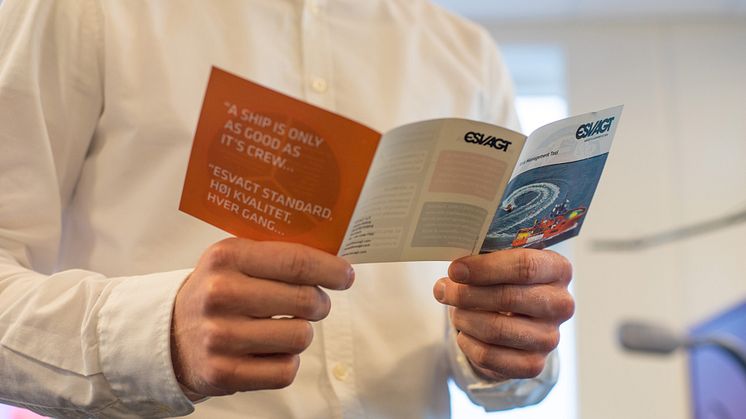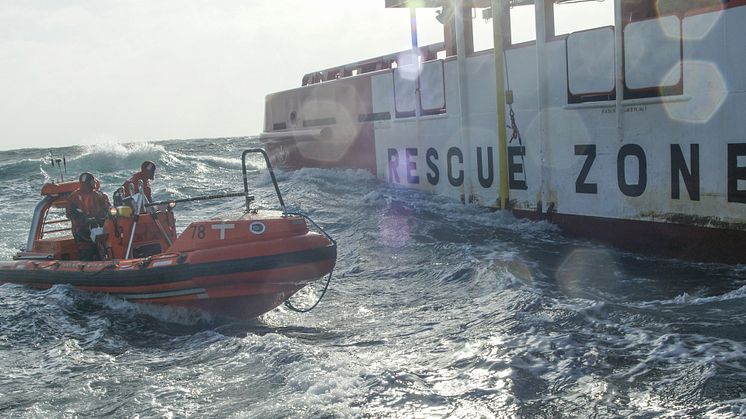
Press release -
Risk Management is not variable
New Risk Management Tool to unify understanding of risk at ESVAGT.
There is a reason why parents of young men are nervous when their 18-year-old sons pass their driving test and make their debut as drivers. The combination of youth and lack of experience in young men contributes to many traffic accidents.
A similar tendency can also be seen at ESVAGT.
”When we analyse incidents retrospectively, it is clear that our risk evaluation and acceptance varies,” says Jesper Møhring Madsen, HSEQ Manager for ESVAGT:
”Gender, age and experience have an enormous influence on our evaluation and acceptance of risk. It is typically the young who have recently been employed, often ordinary ship assistants but also able-bodied sailors, who get into difficulties,” he explains.
Uniform approach
It is not only the new who are too optimistic in risk evaluation and willingness; older, more experienced colleagues also risk losing their awareness through routine – and this has an effect on their risk evaluation and willingness.
But risk is risk – and evaluating it should not be a variable that depends on who is looking at it.
HSEQ and Ship Management have therefore worked together to unify how tasks are viewed. Steffen Rudbech Nielsen, Head of Ship Management, believes that increased focus on evaluating risk from a common standard will make a difference:
”We are very focussed on giving our customers what they expect – and preferably a little more, which is very admirable. But is does open up for a risk that some colleagues are willing to take chances that others are not prepared to take,” says Steffen Rudbech Nielsen:
”We can standardise our approach to our work, its execution and not least our re-establishment of the workplace, so we can also eliminate some of the incidents that are caused by individual risk judgements,” he says.
One tool for this is a new Risk Management Tool.
”Over the years, through our senior officers, we have worked a great deal on how we approach our work; how we complete our tasks to the standard for which ESVAGT wants to be known. We have established a standard for quality and ensured that we meet that standard in everything we do,” says Jesper Møhring Madsen:
“In turn, our senior officers are very flexible in how we execute the tasks we perform. This is where we would like to systemise our work with a new Risk Management Tool,” he explains.
Respecting our reputation
The Risk Management Tool is in essence a dialogue and mindset based on changing our approach to how we evaluate risk using new parameters. As part of this process, ESVAGT has worked with experts in the field of safety from the company, Green-Jakobsen and looked at safety from a helicopter perspective. We have found inspiration in many places, including STATOIL’s A-standard. The essence of Risk Management is accountability; owning and showing responsibility – both to one’s self and not least to our customers and business partners:
”When we talk about risk, traditionally we think of limbs: fingers, eyes, arms and legs, for example. From now on we would like to evaluate risk according to four elements: people, environment, business/reputation and assets in that order,” says Jesper Møhring Madsen.
Between the ears
This change in focus on risk is a further development in our safety culture. We have moved from ‘blame culture’, where mistakes could cost jobs, to a ‘no blame culture’, where we are pleased to uncover mistakes but these rarely had any personal consequence as long as they were reported.
We now have a ’fair and just culture’ that everyone in the shipping company strives for based on ESVAGT’s values:
”The common denominator is responsibility,” explains Steffen Rudbech Nielsen:
”In this industry, you have to be able to account for your actions. The actions we take have consequences – and this must also be true for the individual. You can be unlucky or make wrong decisions; we all make mistakes but we cannot continue making the same mistakes without there being a consequence. We have to be able to trust each other and expect that each of us acts as we would ourselves,” he says:
”We cannot control safety with tools any more than we do already. It is what we have between our ears that will take us to the next level,” says Steffen Rudbech Nielsen.
Topics
Categories
ESVAGT is a dedicated provider of safety and support at sea, founded on an experienced and well-trained offshore crew and unmatched rescue capabilities.
We support the offshore Oil & Gas industries with a wide range of specialized services: Standby, Emergency Response and Resque Vessels (ERRV), Oil spill response, Firefighting, Tanker assists, Rig moves, Supply services and Interfield transfer of cargo and personnel.
In 2010, ESVAGT brought the dedicated offshore wind Service Operation Vessels (SOV) to the market. The SOVs provide accommodation for up to 40 technicians, storage for small turbine parts and a workshop, plus personnel and equipment transfer capabilities by either Walk-to-Work gangway system or Safe Transfer Boats.
ESVAGT was founded in 1981 and has a fleet of more than 40 vessels and more than 900 employees on- and offshore.


